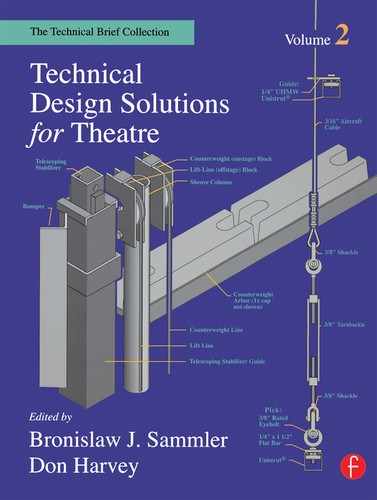A Wheel-less Revolve |
Jim Ryan |
The Laguna Playhouse mounted a production of Alan Ayckbourn’s Communicating Doors which required a small rotating unit containing two walls, each including a door. This unit acted as a “time machine” transporting the actor to different time periods. Since the director and the designer did not want to build a false floor to accommodate a revolving platform, we needed to construct a revolving unit that was as thin as possible and level with the show floor. Since it was impossible to find a wheel small and strong enough to accomplish this, I created a design for a revolve that was only 1 ½″ tall, ran smoothly, was virtually noiseless, and had no wheels.
I have often used Ultra High Molecular Weight plastic (UHMW) for guides and glides and thought why not as a surface for a revolve? The revolve was only 6’-0″ in diameter and it didn’t have to sustain a great deal of weight; at most only the weight of the two wall/door units and two actors. The revolve was constructed of four layers ¼″ plywood and one layer ¼″ UHMW for an overall thickness of 1¼″ as shown in Figure 1.

FIGURE 1: SECTIONS THROUGH REVOLVE
The top layer was a full 6’-0″ in diameter. The remaining layers of plywood were 5′-11″ in diameter to accept the roller chain that would drive the revolve. Given an overall revolve diameter of 6′-0″ each plywood layer consisted of two semicircles. When the layers were glued together with flooring adhesive, the seams of adjoining layers were offset 45°.
A 3″ perimeter ring of oil-filled UHMW (McMaster-Carr Catalog #84945K413) was mounted to the bottom of the plywood layup. The UHMW ring’s outer diameter measured 6’-0″ and its inner diameter, 5’-6″. The ring was cut from six 24″ × 24″ × ¼″-thick pieces ($32.29 each). I used the first method illustrated in Figure 3 to cut sweeps from the UHMW squares. Figures 3.4 and 3.5 illustrate an alternate approach.
It takes nine full-size sweeps and one smaller one trimmed to about 5″ long to complete a ring 6’-0″ in diameter. I used four 24″-square UHMW pieces to make two complete rings — one for the revolve, and one for the floor. The UHMW rings were drilled and countersunk to receive the flat-head wood screws joining them to the revolve and the stage floor. Adding the rings made the overall thickness of the revolve 1½″.

The two remaining 24″ squares of UHMW were used to support the center of the revolve. Each piece was cut into a 2’-0″ ring with an inner diameter of 1’-0$#x2033; to accommodate the pivot point. I pre-drilled and countersunk a few holes in each piece and screwed one to the floor and one to the bottom of the plywood layup.
The pivot point for the revolve was a 3″ square piece of ¼″ steel plate with a 1″-long piece of 1½″ round steel bar welded to it. The plate had pre-drilled holes and was fastened to the stage floor with 1¼″ ×¼″ lag screws. At the center of the revolve I drilled a ½″ hole through the bottom three layers of plywood to accept the pivot point. When the revolve was placed on the pivot point, its UHMW rings lined up with those on the stage floor.
A #35 roller chain was placed in the groove created by making the revolve’s top layer of plywood and perimeter UHMW ring 1″ wider than the middle layers of the revolve. The chain went through a small hole cut in the upstage wall of the set, passed through a series of idler sprockets and was connected to a variable-speed motor drive, which revolved the disk on cue. In the end, the revolve made a half-turn in about 10 seconds. When we tested the revolve by having six stagehands stand on it and turning on the motor drive, it worked without any hesitation or slipping.
To help hide the fact that the revolve was higher than the rest of the set, we added a small ramp around its perimeter. The ramp was made by cutting many small wedges out of scrap pine and fastening them to the floor around the revolve and covering them with Masoniten®. Since the incline of the wedges was minimal, there was no discernible difference between the height of the revolve and the height of the carpeted stage floor.

FIGURE 3: TWO METHODS FOR CULTING SWEEPS
The revolve worked flawlessly for 15 revolutions per performance for 40 performances plus several tech rehearsals. When the set was struck, the revolve showed few signs of wear and the UHMW still had traces of oil.
